Pottery of ancient Cyprus
The pottery of ancient Cyprus starts during the Neolithic period. Throughout the ages, Cypriot ceramics demonstrate many connections with cultures from around the Mediterranean. During the Early and Middle Bronze Ages, it is especially imaginative in shape and decoration. There are also many early terracotta figurines that were produced depicting female figures.
Neolithic Age
The earliest widely used ceramics during the 5th millennium BC are of the Dark Faced Burnished Ware type.[1] This ceramic technique was followed by the following techniques
- Red on White ware
- "Combed ware" [2]
- Painted and Combed ware, a combination of the two previous types
Bronze Age
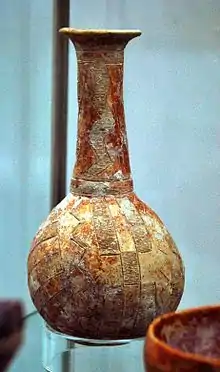

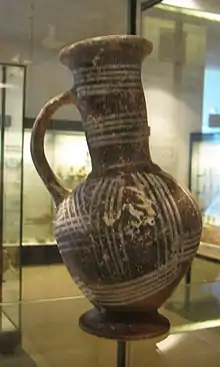
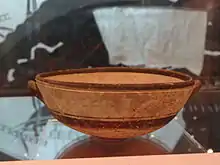
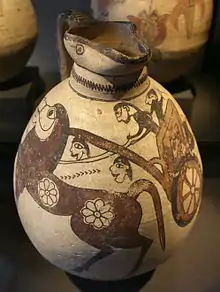
"Red Polished Ware" has been found from the start of the Bronze Age in Cyprus.[3]
White-slip- and Base-ring Ware are considered to be "typical Cypriot ceramics of the Late Bronze Age".[4]
Early Iron Age
During the Iron Age the pottery was "colorful and often elaborately painted with geometric or figural motifs. Intricate 'Free-field' compositions graced juglets and jars. Ubiquitous concentric circles were applied to jars, juglets, bowls and kraters using multiple brushes. Finer wares like plates, bowls and jugs were made on the fast wheel, while larger forms like amphoras, amphoroid kraters and pithoi were built with a combination of techniques: wheel throwing, hand coiling or molding."[5]
Cypro-Geometric I
During the period 1050-950 BC, characteristic pottery were[6]
- "White Painted I"
- "Bichrome I" Ware"
- "Plain White I"
- "Black Slip I"
Cypro-Geometric II
During the period 950-850 BC, characteristic pottery were[7]
- "White Painted II Ware"
- "Bichrome II"
- "Plain White II"
- "Black Slip II"
Cypro-Geometric III
During the period 850-700 BC, characteristic pottery were[8]
- White Painted III Ware
- Bichrome III
- Plain White III
- Black Slip III
- Red Slip I
- Black on Red I
- Grey & Black Polished I
Cypro-Archaic I
During the period 700-600 BC, characteristic pottery were[9]
- White Painted IV "Free-field Style"
- Bichrome IV "Free-field Style"
- Plain White IV
- Black Slip IV
- Red Slip II
- Black on Red II
- Grey & Black Polished II
- Bichrome Red I
Cypro-Archaic II
During the period 600-475 BC, characteristic pottery were[10]
- White Painted V Ware
- Bichrome V
- Plain White V
- Black Slip V
- Red Slip III
- Black on Red III
- Bichrome Red II
Cypro-Classical I
During the period 475-400 BC, characteristic pottery were[11]
- White Painted VI Ware
- Bichrome VI
- Plain White VI
- Black Slip VI
- Red Slip IV
- Black on Red IV
- Bichrome Red III
- Black & Grey Lustrous I
- Stroke Polished I
Cypro-Classical II
During the period 400-323 BC, characteristic pottery were[12]
- White Painted VII Ware
- Bichrome VII
- Plain White VII
- Red Slip V
- Black on Red V
- Black & Grey Lustrous II
- Stroke Polished II
Gallery
.JPG.webp) White Slip II Ware—14th-13th centuries BCE
White Slip II Ware—14th-13th centuries BCE
Israeli National Maritime Museum, Haifa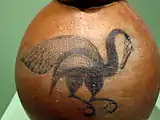 Black on Red II Ware, 750-600BC
Black on Red II Ware, 750-600BC
Museum of Cycladic Art at Athens, Greece Bichrome Red III Ware ; (600-480 BC);
Bichrome Red III Ware ; (600-480 BC);
Kunsthistorisches Museum, Vienna
References
- Joanne Clarke. Insularity and identity in prehistoric Cyprus, in : Le néolithique de Chypre: actes du colloque international organisé par le Département des antiquités de Chypre et l'École française d'Athènes, Nicosie, 17–19 mai 2001. École Française d’Athènes, Athens.
- Flourentzos, P. (1996). A Guide to the Larnaca District Museum. Ministry of Communications and Works - Department of Antiquities. p. 6. ISBN 978-9963-36-425-1. by P. Flourentzos, author and Curator of Archaeological Museums and Surveys in Cyprus.
- Stewart, J.R., Dikaios, P. (1972). "Part 1A". The Swedish Cyprus Expedition:The Stone Age and The Early Bronze Age in Cyprus. IV. Lund. p. 202.
- Flourentzos, P. (1996). A Guide to the Larnaca District Museum. Ministry of Communications and Works - Department of Antiquities. p. 21. ISBN 978-9963-36-425-1.
- The Semitic Museum at Harvard University "Materials & Wares: Iron Age Pots and Potters"
- Gjerstad's Iron Age Pottery Typology & Chronology, Harvard Semitic Museum
- Gjerstad's Iron Age Pottery Typology & Chronology, Harvard Semitic Museum
- Gjerstad's Iron Age Pottery Typology & Chronology, Harvard Semitic Museum
- Gjerstad's Iron Age Pottery Typology & Chronology, Harvard Semitic Museum
- Gjerstad's Iron Age Pottery Typology & Chronology, Harvard Semitic Museum
- Gjerstad's Iron Age Pottery Typology & Chronology, Harvard Semitic Museum
- Gjerstad's Iron Age Pottery Typology & Chronology, Harvard Semitic Museum
| Library resources about Pottery of ancient Cyprus |
Further reading
- Boardman, John. 2001. The History of Greek Vases: Potters, Painters, Pictures. New York: Thames & Hudson.
- Cook, Robert Manuel, and Pierre Dupont. 1998. East Greek Pottery. London: Routledge.
- Farnsworth, Marie. 1964. "Greek Pottery: A Mineralogical Study." American Journal of Archaeology 68 (3): 221–28.
- Gjerstad, Einar, and Yves Calvet. 1977. Greek Geometric and Archaic Pottery Found In Cyprus. Stockholm: Svenska institutet i Athen.
- Luke, Joanna. 2003. Ports of Trade, Al Mina and Geometric Greek Pottery In the Levant. Oxford: Archaeopress.
See also
| Wikimedia Commons has media related to Cypriotic pottery by style. |
